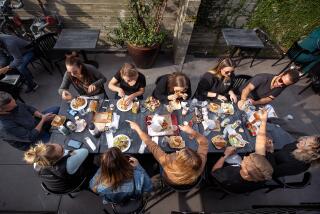‘Smart Choice’ food label: a sign of nutrition or marketing?
Most shoppers know that cabbage and carrots are smart choices at the grocery store.
But it might surprise people that Lucky Charms, Froot Loops, Ritz Bits Peanut Butter Chocolatey Blast crackers and Kid Cuisine Magical Cheese Stuffed Crust Cheese Pizza meals are billed as “Smart Choices” under a controversial new food-rating program.
A logo adopted by food company giants is showing up in major supermarkets: a green Smart Choices check mark meant to replace the blizzard of health labels that clutter food package fronts: “Sensible Solution, “Smart Spot,” and so on.
Sponsors say the logo will help an overweight and overwhelmed public make better food choices in a way that reflects how people really shop.
Critics say Smart Choices won’t help end confusion because its nutrition standards are far too lenient. They see the program as an attempt by food companies to bill less-than-stellar processed foods as nutritious.
They are especially steamed by the breakfast cereal category because so many sugary cereals got a stamp of approval.
“Froot Loops? Froot Loops! I rest my case,” said Marion Nestle, nutrition professor at New York University. “No nutritionist I know would recommend Froot Loops for breakfast.”
A congresswoman has asked the Food and Drug Administration to investigate whether products have been “misbranded.”
The American Dietetic Assn., American Diabetes Assn. and Tufts University’s school of nutrition, each of which has members on the Smart Choices board, have asked Smart Choices to remove the institutions’ names from the Web page listing board members. Though the individuals are involved in the program, the institutions are not, said spokesmen for each.
Smart Choices originated in meetings among food manufacturers, dietitians, academics and others called by the Keystone Center, a nonprofit public health group based in Keystone, Colo. FDA officials sat in on discussions.
The program sets clear, public criteria for foods in 19 categories, including cheeses and cheese substitutes; snack foods and sweets; breakfast cereals; fats, oils and spreads; meals and entrees. Fresh or frozen fruits and vegetables without additives automatically qualify.
Within each category, the logo is meant to indicate products that are more healthful based on nutrients to encourage (such as calcium, fiber and some vitamins and minerals); substances to limit (including fats, sugars and sodium); and food groups to encourage (fruits and vegetables, whole grains and low- or nonfat dairy).
Ten companies -- including Kraft Foods, ConAgra Foods, Kellogg Co., Sun-Maid Raisin Growers of California and PepsiCo -- are taking part, and more than 2,000 products have received a Smart Choices logo, program administrators say. They expect that total to double within months.
There is a sliding scale for participation: Companies that sell $75 million a year or less in Smart Choices products, for example, pay a $2,500 annual fee. The fee per product is negligible, a Smart Choices official said.
Nutritionists who dislike the program are angry for several reasons.
They say it’s inappropriate that their professional group, the American Society for Nutrition, is involved. Smart Choices is administered by the ASN in partnership with a nonprofit group, and has four industry representatives on its nine-member board of directors.
“The public deserves sound nutrition advice, and this needs to be independent of industry,” said dietitian Leslie Mikkelsen, managing director of the Prevention Institute in Oakland.
Critics also are irked by the criteria, which permit items such as Cocoa Krispies, Lunchables Chicken Dunks, Wheat Thins and Fruit Roll-Ups Crazy Pix to qualify for logos along with brown rice, turkey breast and vegetables.
But the most contentious issue -- and the stickiest for the program, according to some who participated in discussions -- is the amount of added sugar permitted in breakfast cereals.
After vigorous debate, the program allowed a Smart Choices cereal to contain up to 12 grams -- 48 calories -- of added sugar per serving. That could be 40% or more of the serving’s total calories.
“Most of the most heavily advertised breakfast cereals -- [such as] Lucky Charms -- all qualify,” said Jackie Thompson of the Rudd Center for Food Policy and Obesity at Yale University, who was not in the group planning the system. “If they all qualify, it doesn’t offer the consumer much information. They’re ‘smart,’ but smarter than what?”
Michael Jacobson, executive director of the advocacy group Center for Science in the Public Interest, said he resigned from the committee charged with designing Smart Choices about a year ago over the sugar allowance, among other reasons.
“The cereal industry put down its foot and said, ‘It has to be 12 grams or we’re not going to participate,’ ” Jacobson said.
But Michael Hughes, vice president for science and public policy at the Keystone Center and a member of the Smart Choices board, said none of the critics had presented scientific evidence that the program’s criteria were out of line with a nutritious diet.
The committee, Hughes said, used the federal Dietary Guidelines for Americans, National Academy of Sciences reports and other research to come up with the program, which can evolve as the science changes, he said.
The program also -- appropriately, he thinks -- considered consumers’ desires for taste, nutrition and convenience. Sure, it might be ideal to grow arugula, pick it in the evening and make a big salad for dinner, but “that’s not a choice everyone will make,” he said.
The cereal objections are also unfair, said Joanne Lupton, a member of the Smart Choices guidelines committee and a professor at Texas A&M; University. Cereal provides an array of nutrients and is a good breakfast, she said, especially if the alternative is a sweet roll.
Celeste Clark, a senior vice president at Kellogg and a member of the Smart Choices board, put it another way: Foods that don’t taste good don’t get eaten. Twelve grams of added sugar “seemed to be realistic and achievable,” she said.
In the end, just about all of Kellogg’s cereals made the grade -- in part because some were reformulated, which Clark called an added benefit of the program. Froot Loops, for example, has 3 grams less sugar per serving than it did before Smart Choices, and 2 grams more fiber.
Last week, after learning that Froot Loops had qualified, Rep. Rosa DeLauro (D-Conn.) asked the FDA to investigate the program.
Kevin Brennan, DeLauro’s chief of staff, said, “We’d like to see that Smart Choices be smart choices. Our feeling is that they are not.”
“We share the congresswoman’s concerns and will continue to look very hard at . . . Smart Choices as well as front-of-pack nutrition labeling programs overall,” an FDA spokeswoman said.
Officials from the FDA and the Department of Agriculture wrote to Smart Choices last month, saying the agencies “would be concerned” if labeling systems “were not stringent enough to protect consumers against misleading claims . . . or had the effect of encouraging consumers to choose highly processed foods and refined grains instead of fruits, vegetables and whole grains.”
That’s exactly what the most outspoken critics fear.
“This,” said Nestle of New York University, “is about marketing, not about health.”
--
More to Read
Eat your way across L.A.
Get our weekly Tasting Notes newsletter for reviews, news and more.
You may occasionally receive promotional content from the Los Angeles Times.









